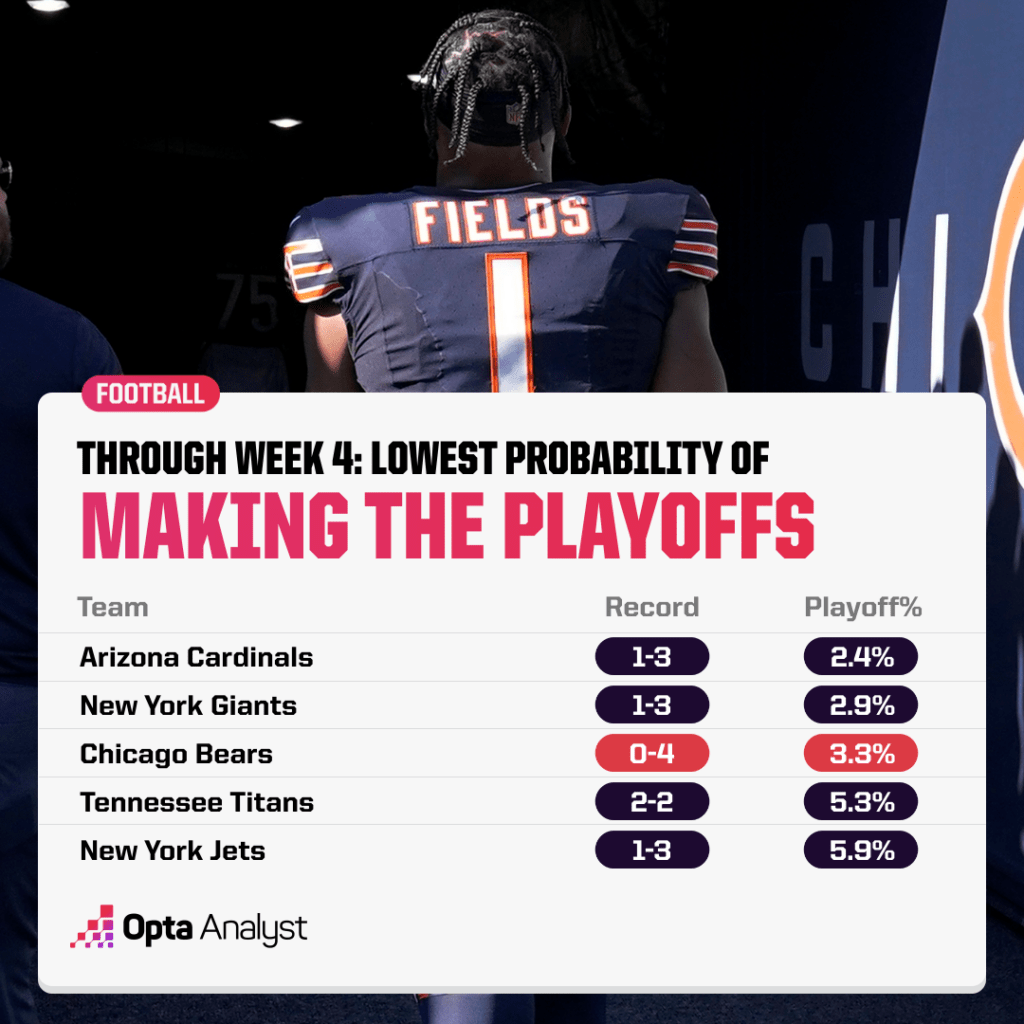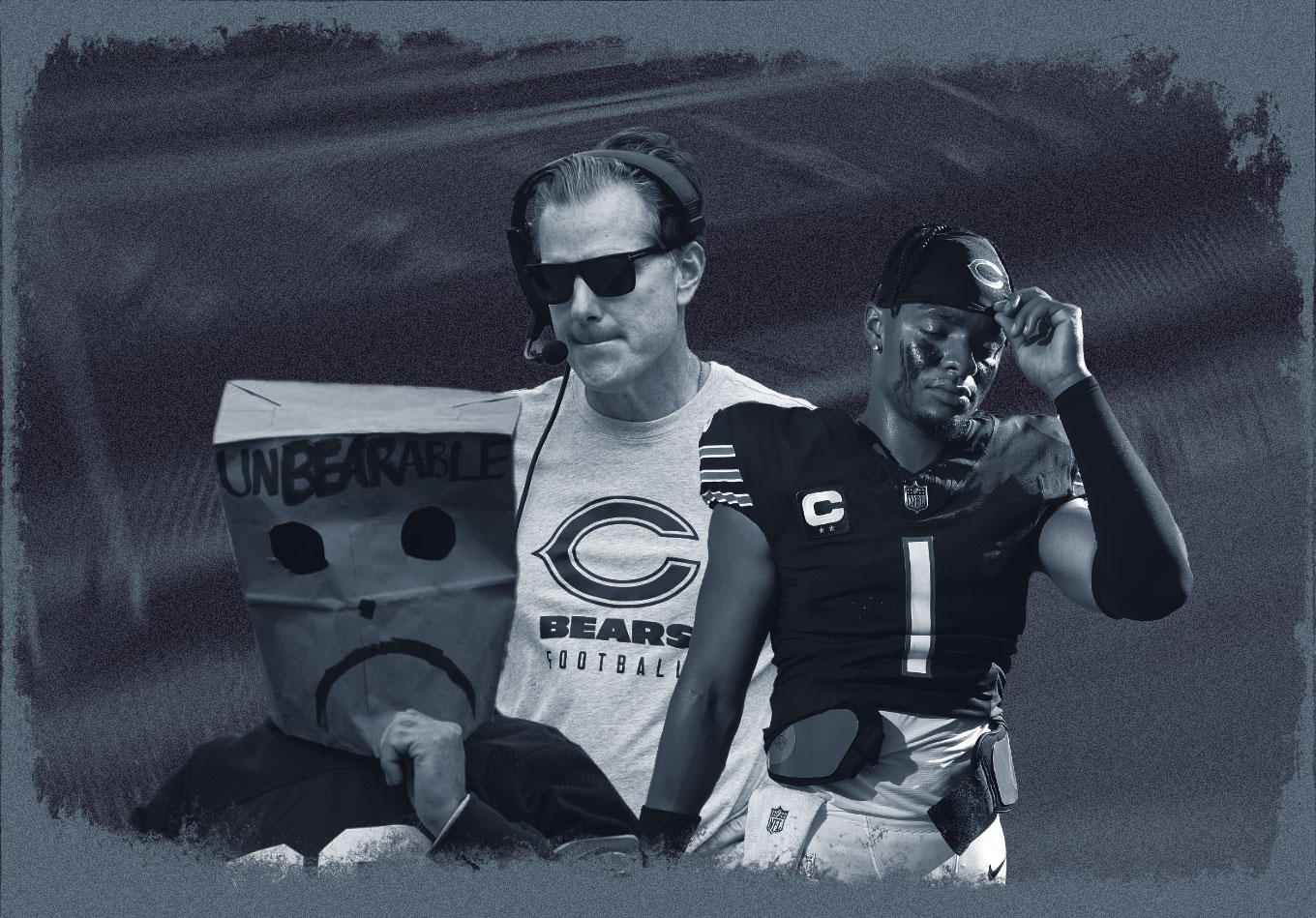Virtually everything has gone wrong in Chicago. Will the Bears’ losing streak finally end Thursday night? And is there still a chance to salvage any discernible on-field progress in 2023? We’re hunting for answers.
The Chicago Bears had the NFL’s worst record in 2022, and all they’ve done in 2023 is run the longest losing streak in franchise history to 14 games and post the league’s worst scoring differential (minus-62) while starting 0-4.
Justin Fields, the hopeful franchise quarterback whose presence prompted the Bears to deal away the first overall pick in last spring’s draft, has posted some of the ugliest stat lines of his three-year career.
The defense has been bad on the field and has already undergone a coordinator change for reasons apparently having nothing to do with that on-field futility. The entire operation has looked rotten, and any long-shot playoff hopes are already close to finished.
Our predictive model gives the Bears a 3.3% chance at playing in the postseason, lower than everyone except the free-falling New York Giants (2.9%) and the sort-of-tanking Arizona Cardinals (2.4%).

Still, though, the Bears should be better than the 3-14 team they fielded last year. At least that was the idea after Fields showed some encouraging signs in the second half of the 2022 season, albeit amid a lot of losses, and after the Bears used the first overall pick and other offseason moves to surround their young QB with an improved supporting cast.
In a month of football, virtually everything has gone wrong. How much of it has a chance to get better heading into Thursday night’s NFC matchup with the Washington Commanders? And is there still a chance for Chicago to salvage any discernible on-field progress in 2023?
The data offers hints about what’s coming.
Fields hasn’t done the job, but he probably isn’t this bad.
There’s no way to spin Fields’ production through four weeks as a sign of great things to come.
He’s thrown interceptions on 4.1% of his passes, which would be the highest mark of his career. And his 4.3 pickable pass percentage is the ninth worst in the league.
He’s averaged 7.0 yards per throw, right in line with his 2021 and 2022 figures. And in large part because the Bears have used him less as a runner than they did last year – when he was in some respects the best mobile QB in the game – Fields has offered less to write home about than ever before.
Those numbers have come despite Fields now having one of the league’s better receivers in DJ Moore and facing pressure on less of his dropbacks (21.4%) than in either of his first two years.
At the moment, the likeliest arc of his time with the Bears is that the team will decline his fifth-year contract option after this season, paving the way for Fields to play elsewhere after his rookie deal lapses at the end of 2024.
But things probably will not stay as bad as they’ve been.
Fields was quite good against the Denver Broncos on Sunday at Soldier Field, posting a 93.9% well-thrown percentage – one of the league’s highest marks in Week 4 – and helping the Bears carry a 21-point lead into the third quarter. His pickable pass percentage was zero (our data analysts evaluated his game-ending interception as a miscommunication with tight end Cole Kmet – another issue with the offensive operation, of course.)
Fields, a prodigious scrambler, gained 23 yards on the two pass plays on which he took off running. He wound up with 335 yards and four touchdowns against the admittedly horrible Denver defense, which was a week removed from letting up 70 points to the Miami Dolphins.
He could revert back to his woeful results of the first three weeks, but it tracks that in the long run, Fields will be better than he was in his first few seasons.
The Bears, after all, acquired a lot of help for him.
The defense is horrendous, but there’s a card it hasn’t played yet.
It’s a grim story on the other side of the ball. The Bears have allowed 6.1 yards per play, worse than everyone except the Broncos team (at 7.0) that beat them on Sunday.
Chicago’s rush defense has let up just 3.7 yards per carry – ranking 10th in the league – but it has given up a successful rush 38.3% of the time – the 12th-worst mark. Run success rate measures how often a team gains a successful play (i.e., 50% of the yards to gain on first down, 70% on second down or 100% on third or fourth downs) on a designed run.
The problem has been defending the pass, where, of course, most elite NFL offenses now make their hay. The Bears are allowing pass catchers to be open 84.4% of the time – the sixth-highest percentage in the league – and only the Broncos (8.1) are surrendering more yards per pass (8.0).
The Bears have faced young quarterbacks (Jordan Love of the Green Bay Packers), retread quarterbacks (Baker Mayfield of the Tampa Bay Buccaneers), elite quarterbacks (Patrick Mahomes of the Kansas City Chiefs) and fading veteran quarterbacks (Russell Wilson), and all of them have managed solid showings against a defense that can’t put four quarters of effective pass defense together.
The Bears have had a gory time trying to get off the field on third downs, letting up a league-worst 58.9% conversion rate, and they’ve yet to meet a QB who can’t carve them up to a decent extent.
The defense could use a philosophical shift. Only the Buffalo Bills (18.0%), Detroit Lions (17.6%) and Arizona Cardinals (14.6%) blitz less than the Bears (20.1%) and only five have a lower pressure rate (32.6%). They’ve only notched two sacks in four weeks, the lowest total in the league.
Chicago’s secondary hasn’t been able to hold up behind a front that barely troubles opposing quarterbacks. The Bears lack dominant pass rushers, but they’d be well served to try sending the house more than they have.
Conservatism isn’t working.
And, of course, the team needs to get its house in order.
Chase Claypool, whom the Bears acquired from the Pittsburgh Steelers for a premium draft pick last season, has been a flop. The Bears told him to stay home from Sunday’s game after he told a reporter that the team hadn’t put him in the best position to succeed. (Claypool has been wildly unproductive since getting to Chicago.)
Claypool’s comments followed Fields pointing to the team’s coaching as the reason for his overly “robotic” play style. Head coach Matt Eberflus has neither the clear trust of his players nor a good path forward. Defensive coordinator Alan Williams is already gone, thanks to a human resources matter.
The Bears’ peripheral numbers say they have the tools to be better than the worst team in the NFL. Their off-field soap opera calls that into question.
They’re 7.0-point underdogs against the Commanders, and if they lose, their fanbase’s attention will turn all the way toward a tantalizing possibility: If both the Bears and Carolina Panthers stay as bad as they’ve been, Chicago will pick both first and second in April’s draft.
That will spell the end of Fields’ time in Chicago, and likely Eberflus’s too, but at least the team will have a light at the end of the tunnel if it hasn’t revealed one by way of playing better.
Check out every team’s chances at making the playoffs in our season predictions. We also have weekly fantasy projections and rankings and use our sit/start comparison tool to help you with lineup decisions. And don’t forget to follow us on X and Instagram.
